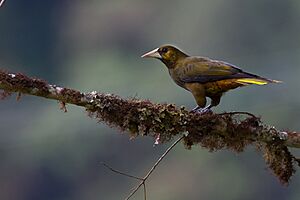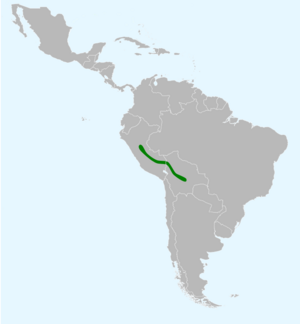Dusky-green oropendola facts for kids
Quick facts for kids Dusky-green oropendola |
|
|---|---|
 |
|
| Conservation status | |
| Scientific classification | |
| Genus: |
Psarocolius
|
| Species: |
atrovirens
|
 |
|
The dusky-green oropendola (Psarocolius atrovirens) is a cool bird from the family Icteridae. This family includes birds often called New World blackbirds.
You can find this bird living on the eastern side of the Andes mountains. It makes its home in countries like Bolivia and Peru. Its favorite places are moist mountain forests and areas where forests used to be.
What Does It Look Like?
The male dusky-green oropendola is about 42 cm (16.5 inches) long. The female is a bit smaller, around 33 cm (13 inches) long. Both males and females look quite similar.
Their feathers are mostly a dark brownish-green or blackish-green color. They have a reddish-brown rump and special feathers under their tail.
The bird's beak is a greenish-white color. Sometimes, you might see a few yellow feathers on its head. Its eyes can be brown or blue. Older birds might have blue eyes.
Another bird, the russet-backed oropendola, lives in some of the same areas. But it has more reddish-brown upper parts. It also has a yellow forehead and an olive-green head that stands out from its back.
Where Does It Live?
The dusky-green oropendola lives on the eastern side of the Andes Mountains. Its home stretches from central Peru down to the Santa Cruz Department in Bolivia.
It likes to live in mountain forests and along their edges. You can find these birds at heights between 800 and 2,600 meters (about 2,600 to 8,500 feet) above sea level. They usually live higher up than the russet-backed oropendola.
What Does It Eat?
This bird's diet includes many different things. It probably eats insects, like moths, and other small creatures called arthropods. It might also eat small animals with backbones.
Besides animals, the dusky-green oropendola also enjoys nectar from flowers and various fruits.
Family Life
The breeding season for these birds is from October to December. They like to build their nests together in groups. However, their colonies are usually quite small.
Is It Safe?
The dusky-green oropendola is a common bird. It lives across a very large area.
The International Union for Conservation of Nature (IUCN) has listed it as a "least concern" species. This means they are not worried about it becoming endangered soon. Even though its forest home is slowly shrinking, the number of these birds is not dropping fast enough to be a big worry right now.


